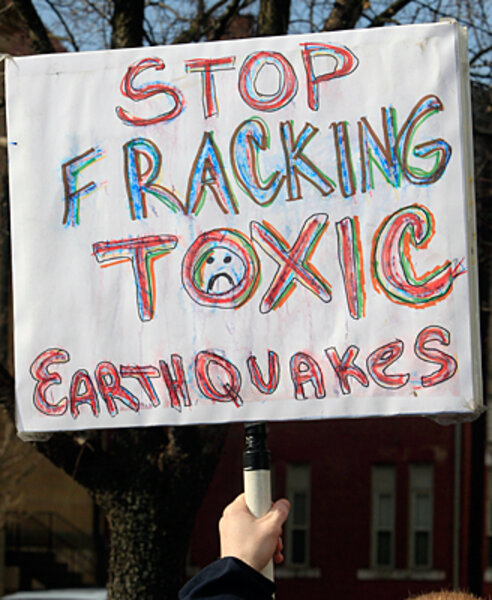Fracking study sends alert about leakage of potent greenhouse gas
Loading...
Fracking may lead to larger releases of methane into the air than previously estimated, according to a new study.
Scientists are now trying to find out if the underestimation is unique to the gas field they examined or whether rogue emissions from such fields are also being underestimated in other areas where there is hydraulic fracturing – or "fracking" – to collect natural gas form certain rock formations.
The study, conducted by researchers from the National Oceanic and Atmospheric Administration's Earth Systems Research Laboratory (ESRL) in Boulder, Colo., suggests that the gas field in Colorado's Weld County leaks roughly 4 percent of its gross annual production into the air. Previous estimates put the leakage at 1.6 percent.
The results come with large uncertainties, notes the team, which included researchers from the University of Colorado at Boulder. The losses could be as low as 2.3 percent or as high as 7.7 percent.
Yet even the low end of that range is higher than previous estimates, notes Gregory Frost, an atmospheric chemist at the ESRL and a member of the team reporting the results in an upcoming issue of the Journal of Geophysical Research.
Fields that rely on fracking tend to leak more methane than fields with conventional wells, some researchers say. Getting an accurate handle on methane emissions is important as a tool in efforts to fight human-triggered global warming.
Efforts to slow global warming primarily focus on reducing carbon-dioxide emissions that come from burning fossil fuels and from land-use changes. CO2 traps heat in the atmosphere, and its concentrations have risen significantly since the Industrial Revolution. CO2 added to the atmosphere remains there for centuries, compounding like interest in an IRA.
Methane's stay in the atmosphere is far shorter than CO2's stay. But molecule for molecule, methane is a far more potent greenhouse gas. Indeed, some researchers make a case that in the short term, reducing methane and soot emissions can be an effective strategy for slowing climate change, improving local public health, and buying time for countries to deal with the politically and economically tougher issue of reducing CO2 emissions.
Beyond its warming potential, methane leaking from oil and gas fields generally is accompanied by compounds that contribute to smog, as well as compounds scientists identify as carcinogens.
Prior to the latest study, the US Environmental Protection Agency and gas companies derived methane-leakage estimates by measuring emissions at a small number of wells in a field, then extending the results to the entire field, says Robert Howarth, an ecologist at Cornell University.
The NOAA/UC-Boulder team used atmospheric-chemistry measurements taken from a 300-foot air-sampling tower north of Denver, as well as measurements taken from an instrument-laden car.
The tower is one of several NOAA has sprinkled around the US to track greenhouse-gas emissions as well as pollutants that affect air quality. Instruments on the tower picked up pulses of methane-enriched air when winds blew from the northeast, where the gas fields – part of a broader area of production known as the Denver-Julesburg Basin – are located.
The relative abundance of methane and volatile organic compounds in a plume varies by source, a feature that allowed the team to match the methane from the northeast to gas fields.
The new results represent one study in one field, and may or may not represent what's happening elsewhere, cautions Dr. Howarth, who led a different study that came to similar conclusions about general leakage rates based on previously published estimates. The study appeared last year in the journal Climatic Change.
But the numbers available to him and his colleagues during their research were “pretty lousy,” he says. The new results represent “the first comprehensive field-based set of measurement we have” on the issue.
The NOAA/UC-Boulder team, led by ESRL scientist Gabrielle Peron, have been in the field in Utah during the past several days working with industry representatives to conduct a more detailed study of the Unita Basin, another gas field. Where the previous study identified the location of the methane, the new work aims to pinpoint individual sources in a field to help guide efforts to reduce emissions.
In April, the US EPA is slated to publish new rules on capturing rogue methane emissions. Until now, emission controls typically applied to oil and gas processing facilities, notes Meleah Geertsman, an air-quality policy specialist with the Natural Resources Defense Council in Washington.
The new rules extend the need for emissions controls to wells and other field equipment, such as compressors and pumps.
Although the new rules leave decisions on when to upgrade these to more-leak-tight versions to the exploration companies, the new rules still represent “a major step forward” in controlling emissions, she says.





